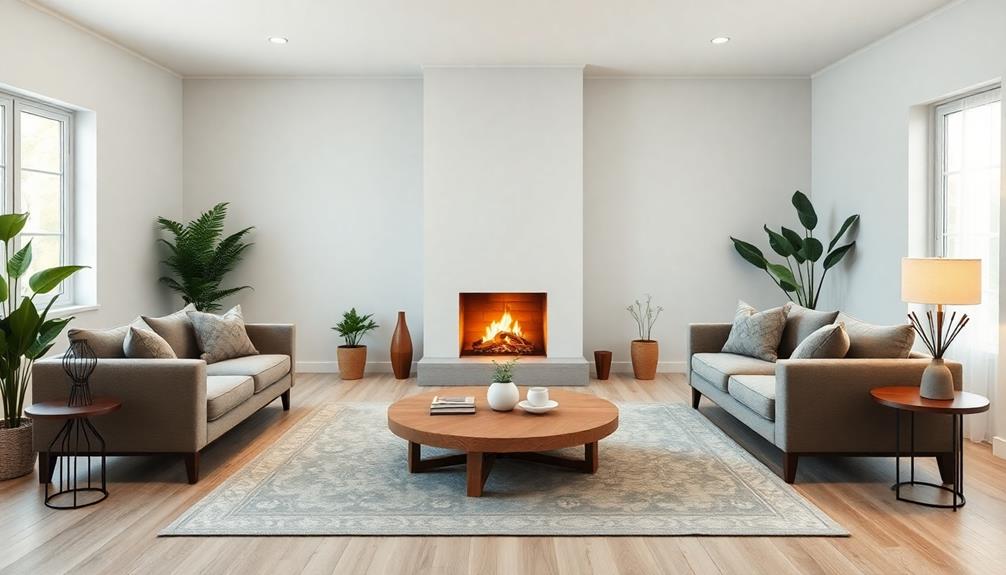Indonesian batik textiles are a must-have for your stylish home. With rich cultural significance and intricate patterns, these pieces add depth to your decor. They transform everyday items into conversation starters while reflecting your personal style. The vibrant colors and craftsmanship enhance both traditional and modern aesthetics, fitting seamlessly into any space. Plus, their versatile use in curtains, pillows, and wall hangings makes them practical and beautiful. By choosing batik, you support sustainable practices and local artisans too. Want to discover how these textile designs can elevate your home decor further?
Key Takeaways
- Batik textiles feature intricate patterns and vibrant colors, adding cultural richness and visual interest to home decor.
- These versatile fabrics can be used in various applications, such as curtains, pillow covers, and quilts, enhancing any interior style.
- Supporting batik artisans promotes fair trade practices, preserving traditional skills and empowering local communities.
- Eco-friendly materials and sustainable production techniques make batik textiles a responsible choice for environmentally conscious consumers.
- The blend of traditional craftsmanship with modern designs allows batik to fit seamlessly into both contemporary and classic home aesthetics.
The Allure of Batik Textiles

Embracing the rich tradition of batik textiles, you'll discover a world of intricate patterns and vibrant colors that tell stories steeped in Indonesian culture. This traditional textile art dates back over 2000 years, and its wax-resist dyeing technique results in stunning designs that can transform your home decor.
Traditional artistry in batik reflects the diverse cultural heritage of Indonesia, making each piece not just a decorative item but a conversation starter. Each batik piece carries cultural heritage, with symbols like the Parang representing power and the Kawung signifying fertility and prosperity. These meanings not only add depth but also enrich the storytelling aspect of your living space.
The versatility of batik fabric means you can use it in various home decor items, including curtains, pillow covers, and wall hangings. This allows you to enhance both visual appeal and texture throughout your home.
Plus, contemporary batik adapts to modern tastes with fresh colors and designs, making it relevant for today's interior design trends.
Cultural Heritage and Significance

Batik textiles not only showcase stunning artistry but also embody a deep cultural heritage that resonates throughout Indonesia. With a history spanning over 2000 years, batik is one of the oldest textile traditions in the world. Each piece reflects the various regional influences, showcasing unique batik motifs that tell stories of local culture, nature, and history. These patterns often carry significant symbolic meanings, connecting wearers to their roots.
As you explore Indonesian culture, you'll find that batik isn't just confined to traditional clothing; it's woven into the fabric of contemporary Batik fashion and interior design. Younger generations are actively embracing these traditional motifs, ensuring that the essence of batik remains vibrant and relevant.
To help you appreciate this cultural heritage, here's a glimpse of batik's significance through a simple table:
| Aspect | Description | Example |
|---|---|---|
| Origins | Over 2000 years old | Traditional ceremonies |
| Techniques | Wax-resist dyeing | Intricate designs |
| Symbolism | Reflects nature and culture | Regional motifs |
| Contemporary Use | Influences modern fashion | Contemporary clothing lines |
| Global Relevance | Gaining appreciation worldwide | International designers |
Crafting Techniques and Processes

Crafting Indonesian textiles involves a meticulous process that highlights both artistry and tradition. The journey begins with plain natural fabrics like cotton or silk stretched on a frame, where artisans use a canting to apply hot wax. This wax resist technique is vital for creating stunning batik patterns, as it protects certain areas from dye.
After the wax is applied, the fabric is immersed in a dye bath, allowing the color to saturate the unprotected sections, forming intricate designs. The rich cultural heritage represented in these textiles enhances their appeal, making them a perfect complement to unique artistic expressions.
Once the dyeing is complete, the next step is the waxing out process. You'll see artisans heat the fabric to remove the wax, revealing the vibrant patterns underneath. They then wash the fabric to eliminate any excess dye, ensuring the final piece is ready for fashion.
In batik production, different tools are essential. The canting is used for fine lines, while a tjanting creates thicker ones.
Additionally, traditional Batik techniques vary, with Batik Tulis relying on freehand artistry and Batik Cap using stamps for mass production. Each method showcases the craftsmanship that goes into every textile, making them truly unique and valuable.
Versatile Applications in Home Decor

You can easily enhance your home decor with the unique features of batik textiles, bringing vibrant colors and intricate patterns into your space.
These textiles share a rich cultural heritage, similar to the intricate designs found in Indonesian decor masks, which tell stories of local myths and traditions.
Integrating these cultural pieces not only adds aesthetic value but also tells a story of heritage and craftsmanship.
From curtains to quilts, the practical uses of batik designs make them a versatile choice for any setting.
Unique Textile Features
Indonesian textile designs, especially those featuring batik, offer a stunning way to enhance your home decor with their intricate patterns and vibrant colors. The unique aesthetic of Indonesian batik can transform everyday items like curtains, pillow covers, and tablecloths into eye-catching focal points.
Its versatile nature allows batik to complement various design styles, whether you prefer traditional or contemporary settings. Additionally, incorporating traditional elements such as floral motifs and bold colors can further elevate your decor.
Moreover, the intricate craftsmanship behind these textiles reflects not only artistic heritage but also the stories woven into each pattern. By incorporating batik into your home, you're not just adding beauty; you're embracing a cultural narrative that enriches your living space.
Choosing batik also means opting for eco-friendly home decor. Many batik fabrics are crafted using sustainable materials like cotton and silk, aligning your decor choices with environmental responsibility.
By selecting these textiles, you support local artisans and promote the preservation of traditional textile techniques, ensuring their relevance in modern design.
In essence, Indonesian batik combines unique aesthetic appeal with a commitment to sustainability and craftsmanship, making it an ideal choice for stylish and responsible home decor.
Cultural Aesthetic Integration
Integrating batik into your home decor offers a unique way to celebrate cultural aesthetics while enhancing your living space. These Indonesian textiles, renowned for their traditional designs and motifs, bring vibrant colors and intricate patterns that transform any room.
By choosing batik pillowcases, tablecloths, curtains, or wall hangings, you not only beautify your home but also showcase the rich craftsmanship rooted in local wisdom. Additionally, incorporating Indonesian Decorative Pillows provides comfort while reflecting cultural heritage, making your living space even more inviting.
Batik's versatility means it can adapt to various design aesthetics, from minimalist to eclectic, allowing you to express your personal style effortlessly. Each piece acts as a focal point, inviting conversation and curiosity about the cultural stories behind the art form.
Incorporating these textiles into your decor is more than just a design choice; it's a way to support local artisans and promote sustainable practices.
As you explore the endless possibilities of batik, you'll find that it harmonizes beautifully with your existing decor while adding a unique and meaningful touch. This cultural aesthetic integration not only enriches your living environment but also fosters a deeper appreciation for Indonesian artistry in your everyday life.
Practical Home Uses
Batik fabric offers countless possibilities for enhancing your home decor, making it a beloved choice among design enthusiasts. This beautiful cloth not only adds elegance but also infuses your space with rich culture, reflecting the diverse architectural styles found in traditional and modern Indonesian housing.
You can use batik in various practical applications, allowing you to express your unique style while celebrating traditional craftsmanship. Here are some versatile ideas:
- Curtains: Brighten up your living space with vibrant batik curtains that filter light beautifully.
- Pillow Covers: Add a pop of color and texture to your sofa with unique batik pillow covers.
- Tablecloths: Host stylish gatherings with eye-catching batik tablecloths that spark conversation.
- Wall Hangings: Create stunning focal points in any room with batik wall hangings or tapestries.
- Quilts: Use batik fabrics in your quilting projects for one-of-a-kind pieces that combine art and functionality.
Incorporating batik into your interior design not only enhances the aesthetic appeal but also supports local artisans and preserves the beauty of this cultural textile art.
Modern Interpretations of Batik

Modern interpretations of batik have emerged, enchanting a new audience. You'll find beautiful batik designs that blend traditional craftsmanship with contemporary styles, particularly in brands like Sejauh Mata Memandang. These designers often use batik tulis, a technique that involves using wax to create intricate patterns, and they reinterpret these designs with minimalist aesthetics that fit seamlessly into today's wardrobes.
Additionally, the incorporation of luxury tropical design aesthetics has inspired a fresh approach to batik, making it a sought-after choice for stylish interiors.
The fashion industry is increasingly recognizing the versatility of batik, integrating traditional motifs into everything from casual wear to formal attire. Whether you're dressing up or down, batik adds a unique flair that speaks to your personal style. The resurgence of batik in streetwear shows its adaptability, resonating with younger generations who appreciate its cultural significance while embracing modern fashion trends.
Furthermore, contemporary techniques like digital printing enhance the accessibility of batik, allowing for a wider variety of designs and applications. This innovation not only preserves the art form but also broadens its reach, making batik an essential element in both clothing and home decor.
With its rich textures and vibrant colors, modern interpretations of batik bring an artistic touch to your life.
Sustainable Fashion and Ethical Design

When you choose sustainable fashion, you're opting for eco-friendly materials that have a lower impact on the environment.
This aligns with the principles of Balinese design characteristics, which emphasize sustainability through eco-friendly materials and traditional craftsmanship.
Supporting local artisans not only helps preserve traditional skills but also guarantees fair wages for those creating beautiful batik designs.
This approach fosters a connection between consumers and the craftsmanship behind each piece, promoting a more ethical fashion industry.
Eco-Friendly Materials Usage
In the domain of sustainable fashion, using eco-friendly materials is essential for reducing the industry's environmental footprint.
By choosing textiles made from sustainable materials, you're not just making a style statement; you're also supporting a healthier planet. The vibrant colors and intricate patterns of Southeast Asia Decor beautifully highlight the artistry involved in eco-friendly textiles.
Here are some key benefits of eco-friendly materials:
- Lower Impact: Fabrics like TENCEL™ and organic cotton have a considerably lower environmental impact than conventional textiles.
- Natural Dyeing: Techniques in batik production utilize indigenous plants and roots, eliminating the need for harmful synthetic dyes.
- Circular Fashion: Integrating recycled textiles promotes circular fashion principles, minimizing waste and encouraging resourcefulness.
- Fair Trade Practices: Collaborating with local artisans guarantees that textile production supports sustainable income generation for communities.
- Durability: Emphasizing durable designs helps reduce waste, aligning with eco-conscious consumer demands for longevity.
Supporting Local Artisans
Supporting local artisans in the Indonesian batik industry not only fosters sustainable income generation but also helps preserve traditional crafts. By choosing batik designs for your home, you're contributing to fair trade practices that guarantee artisans receive fair compensation for their labor. This support empowers communities and allows them to thrive economically.
Collaborations with fashion students and designers also play an essential role in enhancing skill development. These partnerships foster innovation while keeping cultural heritage alive. Additionally, using natural dyes from indigenous plants minimizes environmental harm and supports local economies through sustainable material sourcing.
Here's a quick overview of the benefits of supporting local artisans:
| Benefit | Impact | Example |
|---|---|---|
| Sustainable Income Generation | Empowers communities | Fair wages for artisans |
| Preserves Traditional Crafts | Maintains cultural heritage | Batik patterns passed down |
| Ethical Design Practices | Respects artisans and environment | Eco-friendly production methods |
| Skill Development | Fosters innovation | Workshops with designers |
| Fair Trade Practices | Guarantees fair compensation | Transparency in pricing |
Frequently Asked Questions
What Is the Indonesian Textile Technique?
The Indonesian textile technique, known as batik, uses a wax-resist dyeing process. You'll see intricate patterns emerge once the wax is removed, showcasing the rich cultural heritage and artistry of this traditional fabric-making method.
What Is the Famous Fabric Design of Indonesia?
Have you ever admired the intricate beauty of batik? This famous Indonesian fabric design features wax-resist dyeing, showcasing stunning patterns that reflect cultural significance, making each piece a unique story woven into the fabric.
Why Is Batik so Special?
Batik's special because it combines intricate artistry with deep cultural significance. You'll appreciate its unique wax-resist technique, vibrant patterns, and rich history, making each piece not just fabric, but a story woven into art.
How Is Batik Used in Everyday Life?
Isn't it amazing how batik can transform your everyday life? You wear it as clothing, decorate with it, or use it in accessories—each piece adds vibrant artistry while connecting you to rich cultural heritage.
Conclusion
Incorporating Indonesian textile designs, especially batik, into your home decor not only elevates your space but also connects you to a rich cultural heritage. Did you know that batik has been recognized by UNESCO as an Intangible Cultural Heritage of Humanity, highlighting its significance? By embracing these vibrant patterns, you're not just making a style statement; you're also supporting sustainable fashion and ethical design practices. So, go ahead and let batik bring warmth and character to your stylish home!









